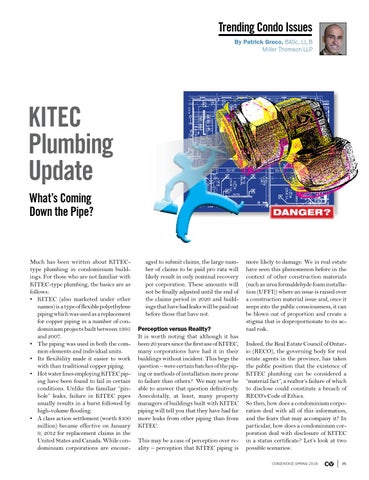Trending Condo Issues By Patrick Greco, BASc, LL.B Miller Thomson LLP
KITEC Plumbing Update What’s Coming Down the Pipe?
Much has been written about KITECtype plumbing in condominium buildings. For those who are not familiar with KITEC-type plumbing, the basics are as follows: • KITEC (also marketed under other names) is a type of flexible polyethylene piping which was used as a replacement for copper piping in a number of condominium projects built between 1995 and 2007. • The piping was used in both the common elements and individual units. • Its flexibility made it easier to work with than traditional copper piping. • Hot water lines employing KITEC piping have been found to fail in certain conditions. Unlike the familiar “pinhole” leaks, failure in KITEC pipes usually results in a burst followed by high-volume flooding. • A class action settlement (worth $100 million) became effective on January 9, 2012 for replacement claims in the United States and Canada. While condominium corporations are encour-
DANGER?
aged to submit claims, the large number of claims to be paid pro rata will likely result in only nominal recovery per corporation. These amounts will not be finally adjusted until the end of the claims period in 2020 and buildings that have had leaks will be paid out before those that have not. Perception versus Reality? It is worth noting that although it has been 20 years since the first use of KITEC, many corporations have had it in their buildings without incident. This begs the question – were certain batches of the piping or methods of installation more prone to failure than others? We may never be able to answer that question definitively. Anecdotally, at least, many property managers of buildings built with KITEC piping will tell you that they have had far more leaks from other piping than from KITEC. This may be a case of perception over reality – perception that KITEC piping is
more likely to damage. We in real estate have seen this phenomenon before in the context of other construction materials (such as urea formaldehyde foam installation (UFFI)) where an issue is raised over a construction material issue and, once it seeps into the public consciousness, it can be blown out of proportion and create a stigma that is disproportionate to its actual risk. Indeed, the Real Estate Council of Ontario (RECO), the governing body for real estate agents in the province, has taken the public position that the existence of KITEC plumbing can be considered a “material fact”, a realtor’s failure of which to disclose could constitute a breach of RECO’s Code of Ethics. So then, how does a condominium corporation deal with all of this information, and the fears that may accompany it? In particular, how does a condominium corporation deal with disclosure of KITEC in a status certificate? Let’s look at two possible scenarios: CONDOVOICE SPRING 2016
CV
35
